Double Bottom Pattern: Definition, Formation, What It Indicates, Parts, and Trader’s Thoughts
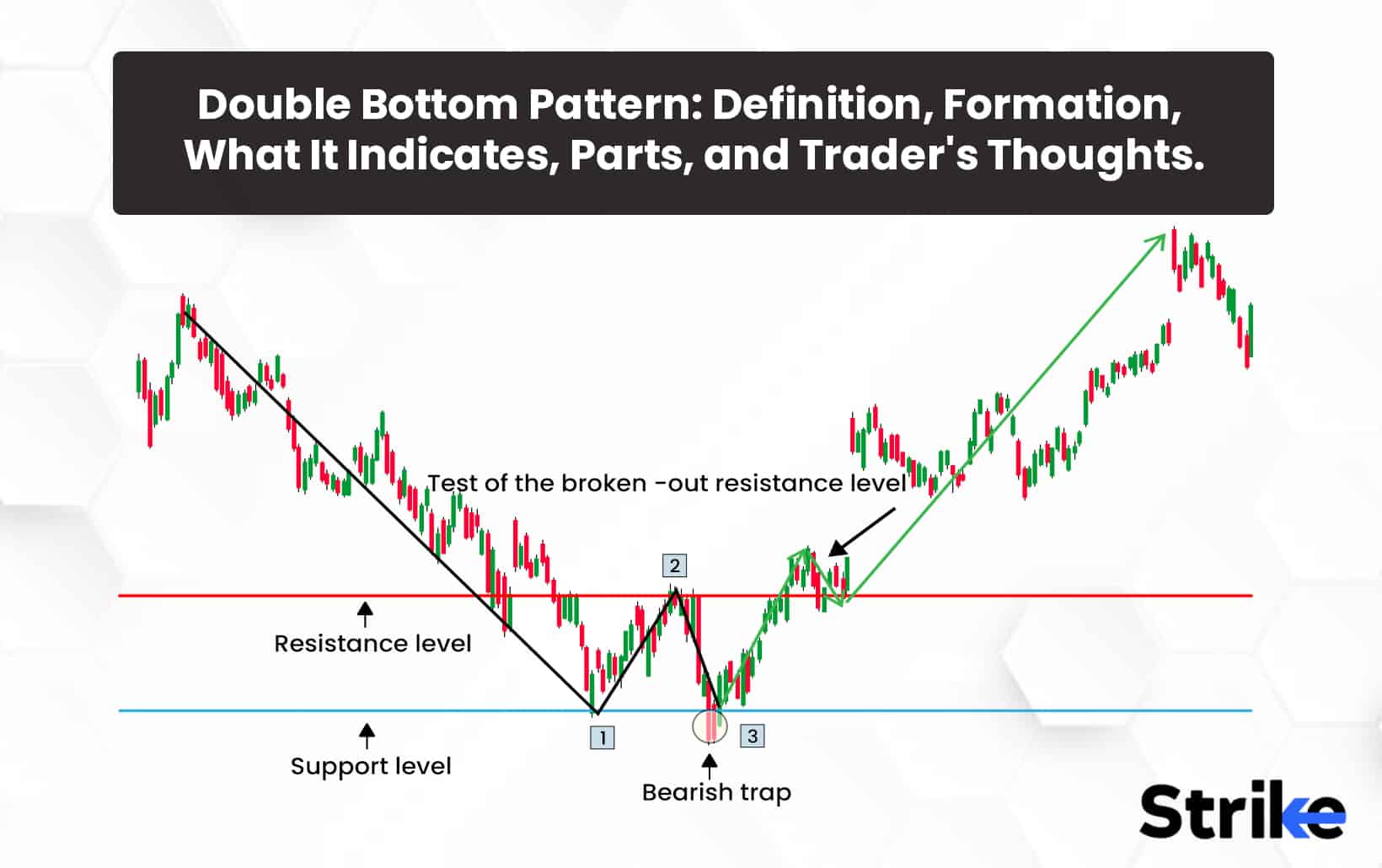
The Double Bottom Pattern is a bullish reversal pattern that occurs at the bottom of a downtrend. The Double Bottom pattern resembles the letter “W” due to the two-touched low and a change in the trend direction from a downtrend to an uptrend. The sellers will be unable to print a new low below the previous low, as the basic rule of technical analysis says that the twice-touched low becomes a support level, which allows the buyers to push the price higher.
The Double Bottom Pattern is also known as the W pattern trading. The highest point of the rebound following the first bottom is considered to be the trigger for the Pattern. A horizontal line is drawn at the highest point of a rebound; this is called the “neckline.” The Double Bottom Pattern is considered a bullish reversal pattern because the Pattern is initiated by a downtrend and finalized in an uptrend. A Double Bottom Pattern is one of the strongest reversal patterns. The Double Bottom Pattern consists of two bottoms, and it’s not a very common pattern. The Pattern is very effective in predicting a change in trend direction when identified correctly.
Its greatest strength is that it offers clearly defined levels. The neckline marks the risk, and it helps determine the take profit. Taking profit is the practice of selling an asset, mostly shares when the asset has risen in price in the Market. The Double Bottom Stock refers to the index’s decline followed by a rebound, an equally significant drop, and another rebound. The double-bottom chart pattern registers a correction in the ongoing downtrend. Many analysts have suggested that the easiest way to recognize a double bottom is to check the two lows. The first low will always mark a 10-20% fall, and the other low will remain within the previous low’s 3-4% range.
The index’s volume will rise once the uptrend is confirmed. A trend reversal is said to begin whenever a Double Bottom Pattern appears, as it generally indicates that a potential uptrend is around the corner. The double-bottom chart Pattern is helpful in trying to predict the intermediate to the long-term price movement of a security. The price of the security moves up after the first bottom, and it will hang around the high for some time, indicating a hesitation to go downward again. This generally means that the demand for the asset is on the uptick but isn’t strong enough yet for a breakout.
What is a Double Bottom Pattern?
The Double Bottom Chart Pattern indicates a trend reversal in the Market. The double bottom chart pattern belongs to the Price Action technical analysis technique, which involves analyzing price movements without using additional technical indicators. The Pattern is characterized by forming two bottoms located approximately at the same level.
There is a small upward correction Between the two lows. The Double Bottom Pattern is a reversal pattern that signals a bearish-to-bullish reversal. The Double Bottom pattern is found in any financial market, including stocks, bonds, Forex, cryptocurrency, and commodity markets. The Double Bottom Pattern is formed both in short-term and long-term timeframes, from 5-minute to monthly ones. A Double-bottom pattern consists of three parts.
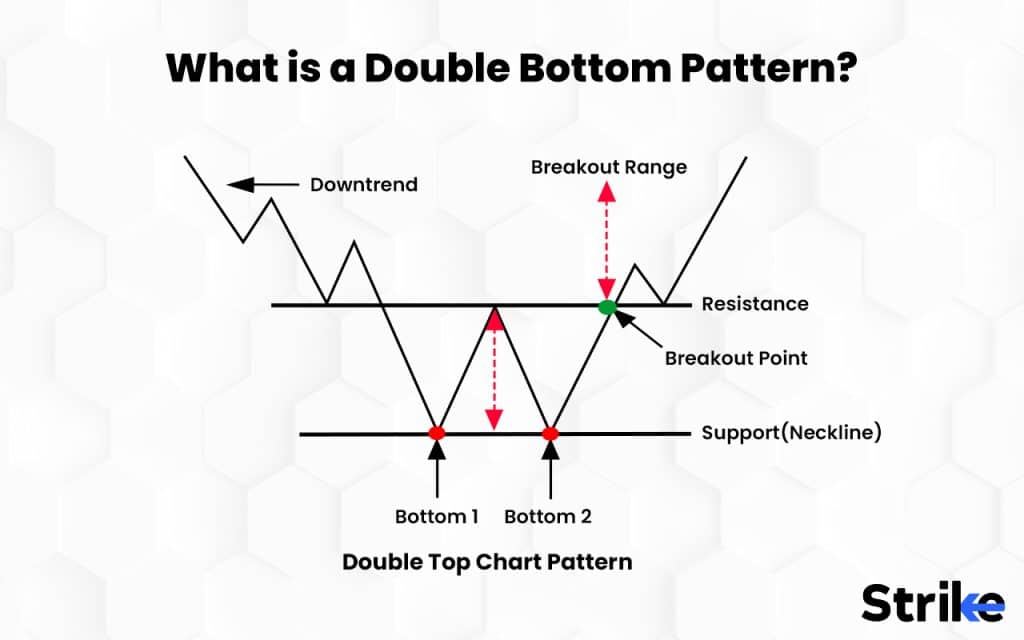
1.First low – first price reversal.
After a strong downtrend, the Market bounces higher. Whenever the price is lower than any other price over a given time, we can see the formation of a swing low. At this moment, it’s likely just a retracement in a downtrend, not an indication of a price trend reversal.
2. Second low – second price reversal.
The second drop is formed as the Market discounts the previous downtrend and the buying pressure increases. There will be signs of a price reversal and an uptrend when the second bottom is formed. It is still, however, too early to say if the prices will continue increasing.
3. Neckline – an area of resistance.
The neckline or resistance level is the maximum price an asset can achieve over a period in an up-trending market. A Double Bottom Pattern is complete if the price breaks above the neckline, indicating there are more buyers than sellers and that the trend is likely to continue moving higher.
Given above is an example of The Double Bottom Pattern: NEW ZEALAND DOLLAR – US DOLLAR CHART.
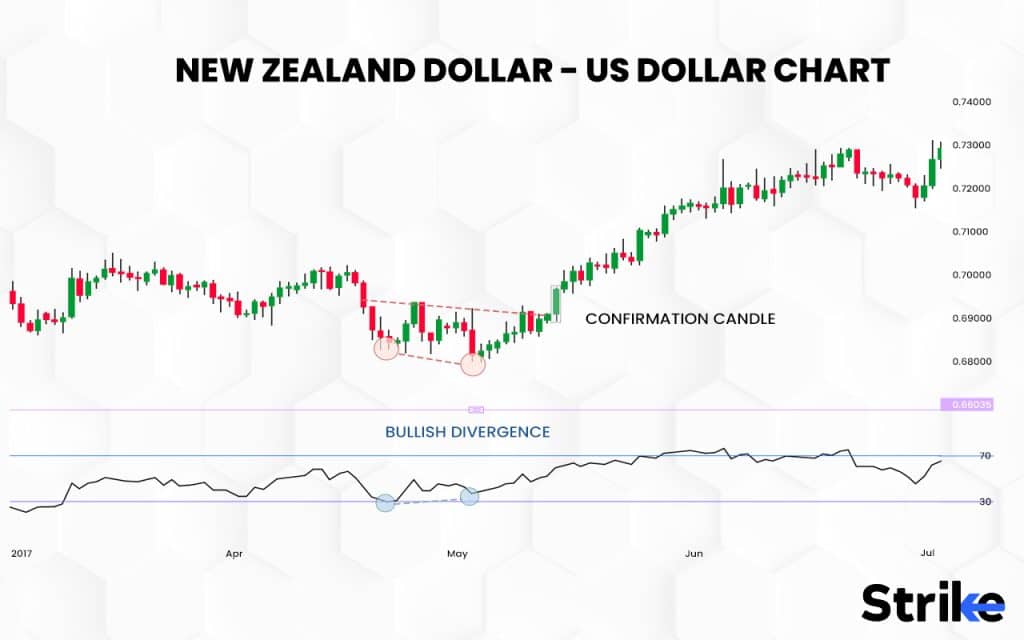
Given above is another example of The Double Bottom Pattern: Apple Inc. Double Bottom Chart Pattern.
The Double Bottom Chart Pattern is a bullish reversal pattern used in technical analysis. It consists of two distinct lows that are roughly equal and separated by a peak in between. The key components of a double-bottom chart are given below.
Downtrend: The Double Bottom Pattern occurs after a sustained downtrend in the asset’s price, indicating that the bears are losing momentum and the bulls are beginning to take control.
First Low: The first low is when the bears are exhausted, and the bulls start to push the price upward. This forms the first bottom of the Pattern in the trade chart.
Interim High: The price then rises to a new high, which marks a temporary resistance level where the bears attempt to push the price down again.
Second Low: The price returns to the first low level, forming a second bottom. This bottom is usually slightly higher than the first and forms the second part of the “W” shape in the chart.
Breakout: The Double Bottom Pattern is confirmed when the price breaks above the interim high, signaling that the bulls have taken control of the Market.
Volume: An important factor to consider when analyzing a double-bottom chart pattern. The volume, generally, should be higher during the second low and breakout, indicating greater buying pressure and conviction among traders.
The Double Bottom Pattern should be used in conjunction with other technical indicators and analysis techniques to make well-informed trading decisions.
What Does the Double Bottom Pattern Indicate in Technical Analysis?
A Double Bottom Pattern is a classic technical analysis chart formation showing a major change in trend from a prior down move. The technical analysis of The Double Bottom is significant because it suggests an important low or strong level of support ( support refers to the price level that an asset does not fall below for a period of time) has been reached following a down move. The Double Bottom Pattern always follows a major or minor downtrend in particular security and indicates a reversal and the beginning of a potential uptrend.
The minimum price target for the formation is the Distance from the previous low to the corrective high in the middle of the formation. So, the target is roughly 10% higher than the initial low of the Double Bottom Pattern chart. The price movement of the Double Bottom Pattern is identified in technical analysis, where there is a fall in price led by a gain, followed by another drop, and finally, a rise in price from a shape that is similar to the letter W.
Investors who want to trade in a double bottom should do so at the second bottom. A Double Bottom is an indicator of positive signals as the Stock reaches its low, and the second bottom will mostly be followed by a continuous increase in the stock price. There are three rules that a trader should follow when trading with double-bottom chart patterns.
- Firstly, one should see the market phase, whether it is up or down. The prior trend will always be a downtrend, as the Double Bottom Pattern is always formed at the end of the downtrend.
- Traders should note if two rounding bottoms are forming and also note the size of the bottoms.
- Traders should only enter the long position when the price breaks out from the resistance level or the neckline.
It is important to note that not all double-bottom patterns will result in a successful reversal. Always consider other technical indicators, confirmatory signals, and market conditions before making trading decisions.
How do you describe the formation of the double bottom Pattern?
The two distinct troughs, or double bottoms, should be identified while looking for the Pattern of the Double Bottom Pattern. The first bottom should be the lowest point of the current trend. The Distance between the two bottoms shouldn’t be too short. The Double Bottom Pattern will hesitate to go downward again when the price of the security moves up after the first bottom, and it hangs around the high for some time. The time duration between one trough and the next could range anywhere between one and three months. Steps to identify a Double Bottom Pattern on a chart are given below
- Look for two notable lowest price points on a chart with a similar height and width.
- The Distance between the two bottoms, the two lows, shouldn’t be too brief, but this depends on your chosen trading time frame.
- Draw the neckline/resistance level.
- To confirm The Double Bottom Pattern, use other technical indicators like moving averages (MA) or oscillators.
- Make sure there’s enough trading volume in the second swing to confirm the trend strength or trend change. Keep in mind not to trade against solid trends.
It’s important to note that pattern recognition should not be the sole basis for making trading decisions. Always combine pattern identification with other technical indicators, confirmatory signals, and thorough analysis of the overall market conditions before making any trading decisions.
What Do Traders Think About the Double Bottom Pattern?
The term “bottom of the hour” is used to refer to the half-hour mark during a trading session. It’s a way to describe the time when 30 minutes have passed in an hour-long segment of trading. For example, a trading session starts at 10:00 AM, which means the “bottom of the hour” would be at 10:30 AM. It’s a common reference point for discussing stock market movements or trends during specific time intervals.
The Double Bottom Pattern is a price action formation on the chart that consists of two swing lows that end around the same level and a swing high between the two low ends. The Double Bottom pattern is seen in a downtrend and also indicates the end of the downtrend, so it is considered a bullish reversal pattern. Decades of research reveal the Double Bottom Pattern has an 88% success rate in bull markets and an average profit potential of +50%. The Double Bottom Chart Pattern is one of the most dependable and accurate chart indicators for investors. The Double Bottom Chart pattern often indicates that the security’s price could soon increase. It should be noted, however, that this indicator does not guarantee a reversal in direction.
The traders should open a long position near the support area and place a stop-loss order below the lower low when the Double Bottom Pattern starts to form. Traders can better manage their risk and maximize their profit by entering potential trades. A Double Bottom in a bull market fails 12% of the time. The stock price also falls below the support area and continues to decline when the Double Bottom Pattern falls. So proper risk management is essential when using Double Bottom Pattern charts in Stock Marketing. The traders have a very good perspective on the Double Bottom Pattern, but it should be used diligently.
What are the parts of a double-bottom pattern?
The Double Bottom Pattern is a popular technical analysis pattern used in trading and investing. It is considered a bullish reversal pattern and typically forms after a downtrend. The 8 major components of the Double Bottom Pattern are given below
- Prior Trend: A significant downtrend within a significant time period should be in place.
- First Trough: The first trough should be the lowest point of the current trend. The first trough, as such, should be normal in appearance, and the downtrend should remain firmly in place.
- Peak: There is an advancement (that typically ranges from 10 to 20%) after the first trough. Volume on the advance from the first trough is usually inconsequential, but an increase could signal early accumulation. The peak is sometimes rounded or drawn out a bit from the hesitation to go back down. This hesitation indicates that demand is increasing in the Market but is still not strong enough for a breakout.
- Second Trough: The decline of the Double Bottom Pattern chart usually occurs with low volume and meets support from the previous low. Support from the previous low should be expected. The trader still needs to confirm the possibility of The Double Bottom Pattern as the changes are low even after establishing the support level. The time period between troughs can vary from a few weeks to many months, with the norm being 1-3 months. A trough within 3% of its predecessor is considered valid.
- Advance From Trough: Volume is more important for the Double Bottom Reversal than the double top. There should be clear evidence that volume and buying pressure are accelerating during the advance off of the second trough. An accelerated ascent, perhaps marked with a gap or two, also indicates a potential change in sentiment.
- Resistance Break: The Double Bottom Pattern is still not complete even after trading up to resistance. Breaking resistance from the highest point between the troughs completes the Double Bottom Pattern. The Double Bottom Pattern should occur with an increase in volume and/or an accelerated ascent.
- Resistance Turned Support: Broken resistance becomes potential support, and there is sometimes a test of this newfound support level with the first correction. Such a test can offer a second chance to close a short position or initiate a long one.
- Price Target: The Distance from the resistance breakout to the trough lows is added on top of the resistance break to estimate a target. This would imply that the bigger the formation, the larger the potential advance. More aggressive targets are the Distance between the two lows and the intermediate high.
It’s important to note that technical analysis patterns are not foolproof and should be used in conjunction with other indicators and analysis techniques for more reliable trading decisions and to maximize profits.
Is the Double Bottom Pattern a Good Signal for a Position?
Yes, the Double Bottom Pattern is a good signal for positioning. The Double Bottom Pattern formations are highly effective when identified correctly, but they can be extremely detrimental when interpreted incorrectly. Therefore, one must be extremely careful and patient before jumping to conclusions. There are mainly two ways to trade the Double Bottom Pattern.
Aggressive traders may want to look for a trading opportunity when the price is making the second low, and conservative traders would wait for the price to break above the neckline, which acts as a resistance level. Traders with a very high-risk appetite may start entering in small quantities if they spot bullish reversal candlesticks at the resistance level when the second trough is forming, with a strict stop loss just below the support formed above the first bottom.
How do you trade using the double-bottom Pattern?
The double bottom is frequently used in the Forex and equity markets as buy/bullish signals. Identifying the emerging Double Bottom is the first step in trading using The Double Bottom Pattern. The extra step involves waiting for the Market to retest the breakout level. The buyers still remain strong and are ready to fuel the coming positive trend when the market holds. Here’s a step-by-step guide on how to trade using the double-bottom Pattern
- Identify the Double Bottom Pattern: Look for a significant downtrend in the price chart followed by two bottoms that are relatively equal in height and separated by a rally.
- Confirm the Pattern: First, identify the Pattern and then confirm its validity by ensuring that the price breaks above the resistance level, which is formed by connecting the highs between the two bottoms.
- Entry Point: Determine the entry point for your trade after the Pattern is confirmed. One common approach is to enter the trade when the price breaks above the resistance level after the confirmation.
- Stop Loss: Place a stop-loss order below the second bottom or below the breakout level to limit potential losses in case the Pattern fails.
- Target Price: Calculate the price target for your trade by measuring the Distance between the resistance level and the bottoms of the Pattern. Then, add that Distance to the breakout point. This is how we find the target price.
There are two main ways to trade a Double Bottom Pattern: first, place an order when the price breaks the neckline, or second, trade when the price retests the neckline, taking a long position. It’s essential to practice proper risk management, conduct a thorough analysis, and consider the broader market context when using the double bottom Pattern or any other trading strategy for reliable trading opportunities.
What are the Benefits of Double Bottom Pattern?
The double bottom is a powerful bullish reversal pattern that can signal a potential opportunity to enter a long position. Traders keep an eye out for double bottoms due to their many advantages, including:
Indicates potential reversal: The double bottom signals a potential reversal from a downtrend to an uptrend. The second bottom test supports and hints the Market may be turning around.
Confirms strong support: The double tap of the same support level confirms it is a strong area of demand. Holding support twice demonstrates buyers are entering at this price.
Signals bullish momentum: Once resistance is broken after the second bottom, it indicates building bullish momentum as buyers gain control.
Provides entry point: Drawing a trendline connecting the two bottoms creates a breakout point for trades. Traders can place a buy-stop order to enter long after support breaks.
Stop-loss strategy: Placing a stop-loss below the lowest point of the double-bottom Pattern limits downside risk. Even if the breakout fails, risk is contained below support.
The Double Bottom Pattern is one of the strongest reversal patterns out there. The double bottom Pattern is highly effective in predicting changes in the trend direction of the stock market. Its greatest strength is that it offers clearly defined levels to play against. It’s important to note that no trading pattern or strategy guarantees 100% success in the Market.
What are the Limitations of Double Bottom Pattern?
The key limitation of the Double Bottom Pattern is that it is a contrarian strategy. The overall trend is bearish, and the trade is long. Hence, the risk is that the market will always continue moving in the same direction. Although it can be a useful tool for traders and investors, it also has certain limitations. Five of them are given below.
- False Signals: The double bottom Pattern is not foolproof and can produce false signals Like any technical analysis pattern. Sometimes, what appears to be a double-bottom pattern fails to result in a bullish reversal.
- Subjectivity in Pattern Recognition: Identifying the double bottom Pattern requires subjective judgment and interpretation. Different traders use different criteria for recognizing the Pattern, which can lead to inconsistencies in its application.
- Lack of Timing: The double bottom Pattern does not provide precise timing for trade entries or exits.
- Market Context: The double bottom Pattern should be considered within the broader market context. It is important to assess the overall market conditions, trends, and other technical or fundamental factors to gain a more comprehensive understanding of the price action.
- Overlapping Patterns: The double bottom Pattern is part of a larger, more complex pattern or formation In certain special cases.
It’s essential to remember that technical analysis patterns should be used as part of a comprehensive trading approach that includes risk management to maximize profit gains.
Why is the Double Bottom Pattern a Bearish Technical Reversal Pattern?
Target bear” in the stock market usually refers to a market condition where prices are expected to fall, leading to a downward trend or bearish sentiment. Investors use this term to describe a situation where they anticipate a decrease in stock prices.
A Double Bottom Pattern will typically indicate a bullish reversal, which provides an opportunity for investors to obtain profits from a bullish rally. A Double Bottom Pattern is a classic technical analysis charting formation showing a major change in trend from a prior down move of the Stock. A bearish reversal pattern is a combination of candlesticks during an uptrend. It indicates that the trend will reverse when the price falls. This is usually the case when bears replace the bulls over time. This is also the case of the Double Bottom Patterns, whose trend changes from bearish to bullish in nature. The Rounding Bottom Patterns will typically occur at the end of an extended bearish trend.
The Double Bottom Pattern is a bullish reversal pattern that occurs at the bottom of a downtrend and signals that the investors, who were in control of the price action so far, are losing the momentum of their stocks. The target of a double bottom pattern is typically calculated by measuring the Distance from the bottom of the Pattern to the neckline and projecting that Distance upward from the breakout point. The neckline is a line that connects the highs between the two bottoms of the Pattern. First, Identify the double bottom Pattern, which consists of two distinct lows, then draw the neckline and Measure the Distance from the bottom of the Pattern.
How do you confirm a double bottom pattern with a break below support?
A Double Bottom Pattern is one of the more commonly used chart patterns in technical analysis. Traders enter the trade completely only once the resistance level is breached by the price (the support and resistance (S&R) are specific price points on a chart pattern expected to attract the maximum amount of either buyers or sellers). The Double Bottom Pattern Chart will give a throwback to the breakout level after the breakout.
Entering after the throwback gives them better risk/reward from the Stock they have invested in. There is a probability that the Pattern turns out to be a rectangle pattern (a rectangle is a chart pattern formed when the price is bounded by parallel support and resistance levels) when the Pattern fails to break out. The trader must look for a significant expansion in volumes to know if a reversal is on the cards when the price of the Stock is upward bound a second time and approaches the neckline.
The stop loss is fixed at the second trough in the Double Bottom Pattern Chart. Always prefer to double the stop loss target over the entry price of the Stock while setting a price target for gains. The Pattern will find a new support level and offer a trader another chance to start a long position or go short when the price of the Stock breaks the neckline (or resistance).
What is an example of a Double Bottom Pattern?
PFE – Pfizer IncE formed a Double Bottom Reversal and broke resistance with an expansion in volume after trending lower for almost a year. PFE declined to 30 in November-99, which was a new 52-week low From a high near 50 in April-99. The Stock advanced over 20% off of its low and formed a reaction high around 37 ½.
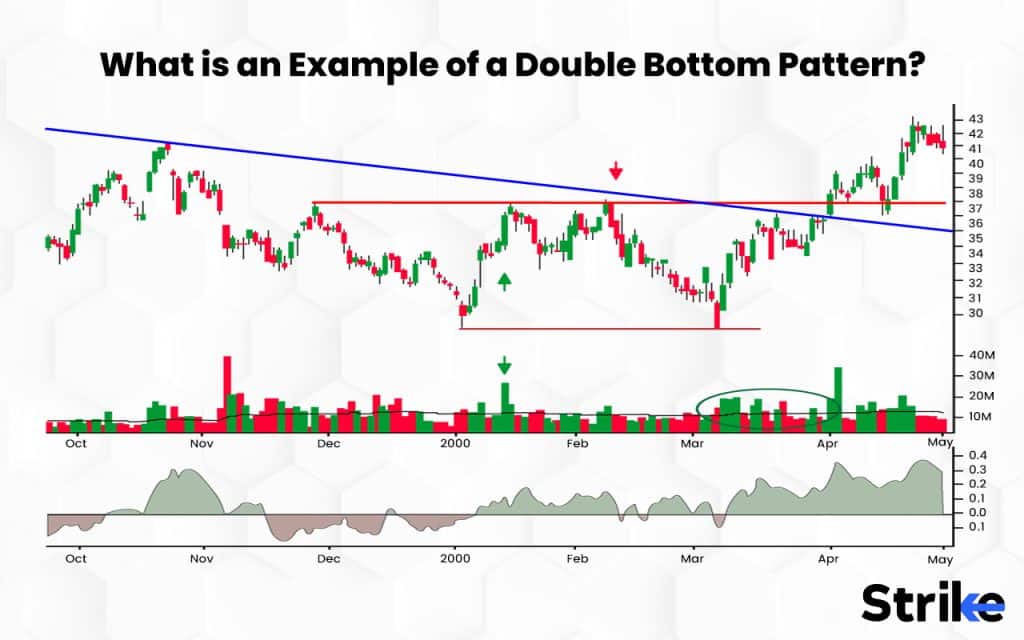
Observe how a breakout leads to a strong rise in the price of the Double Bottom pattern on the weekly charts in 2016 in the example of Adani ports below.
The 1st bottom, along with the 2nd bottom after a prior downtrend and a breakout from the resistance line, or the ‘W’ pattern, forms the Double Bottom Pattern.
What Are the Common Trading Strategies Used for Double Bottom Pattern?
In brief, there are two main ways to trade the Double Bottom Pattern. They are placing an order when the price breaks the neckline and when the price resists the neckline.
1. Place an order when the price breaks the neckline.
The first method to trade a Double Bottom Pattern is to enter a trade when the price of a stock breaks the neckline/resistance of the chart formation. The first option to trade a double bottom pattern is to enter the trade as soon as the Pattern is complete and the price breaks the neckline. Then, place the stop-loss order just below the lows and the profit target above the resistance line.
Blue line: Enter when the price of a stock breaks the neckline.
Redline: Place a stop loss order below the formation.
Green line: Take the height of the Double Bottom Pattern formation and place a desired target that much above the neckline.
2. Place an order when the price retests the neckline.
The second way to trade a Double Bottom Pattern is to wait for some time before buying, see how the trend will change, and place an order when the price retests the neckline. First, wait for the price to break above resistance.
Blue line: Enter the trade after the price retested the neckline as support (in the pink area).
Redline: Place a stop loss just below the new support.
Green line: Place a profit target above the neckline. The Distance is the full height of the Double Bottom formation.
It’s important to note that no trading strategy is foolproof, and it’s advisable to practice proper risk management and use additional analysis and indicators to validate any trading decision and maximize trading profits.
How Important Is It to Place Your Stop Loss When Trading?
The major importance of the Stop-losses is to prevent large and uncontrollable losses in volatile trades. A stop-loss is designed to limit a trader’s loss on a security position that makes an unfavorable move. Another key advantage of using a stop-loss order is you don’t need to monitor your holdings daily. In the case of the Double Bottom Pattern, the “Stop-loss” is placed just below the lows of the Double Bottom Pattern.
Stop losses are critical to avoid the risk of a concentration of positions. A trader needs to stop losses irrespective of whether they are trading on the long side or the short side. Stock markets are highly volatile and unpredictable, so if an investor does not put a stop to loss, then their losses could escalate to a level where they could endanger your trading capital.
The term “bottom of the hour” is used to refer to the half-hour mark during a trading session. It’s a way to describe the time when 30 minutes have passed in an hour-long segment of trading. For example, a trading session starts at 10:00 AM, which means the “bottom of the hour” would be at 10:30 AM. It’s a common reference point for discussing stock market movements or trends during specific time intervals.
Why Should You Set Your Profit Goal?
A profit target is a level at which the profit is deemed to be satisfied. The profit goal is the point you choose, at the time of entering a trade, to exit from the trade if profitable. Your profit target determines the amount of money you intend to make in a trade. A profit goal is a predetermined point at which a trader would want to exit a profitable trade to make an anticipated amount of profit.
The Stock Market doesn’t move in one direction; hence, making use of a profit target goal can help a trader cash in on profits and prevent any potential for losses when the market changes direction. The Distance from the previous low to the corrective high in the middle of the formation is the minimum profit goal for the formation. So, the target is roughly 10% higher than the initial low.
Is the double bottom shape like a ‘W’ pattern?
Yes, the Double Bottom Pattern is shaped like a “w” pattern. A double-bottom chart pattern generally looks like the letter W, marking two price lows (bottoms) and three reversal points. A Double Bottom has a ‘W’ shape and is a signal for a bullish price movement. The Double Bottom formation is constructed from two consecutive Rounding Bottoms forming a “w” shape in the chart. The double-bottom chart pattern is found at the end of a downtrend.
The Double Bottom Pattern has two distinct bottoms of similar width and height. The Distance between the two bottoms should not be too small. The Double Bottom Pattern is a trend reversal chart pattern formed after a continuous downward price movement for a good duration where the downward price movement loses its steam (forms a first bottom) and traces a bit (to the neckline or midpoint). The Double Bottom Pattern Chart then again moves in the direction of the original trend and reaches the first bottom level, thereby forming the second bottom.
The Pattern resembles the letter “W” because of the two-touched low and a change in the trend direction from a downtrend to an uptrend; the twice-touched low becomes a support level. We have two lows and two bottoms that resemble the letter “W,” as the traders are unable to print a new low below the previous low, which provides them with an opportunity to push the price higher. This is the fundamental rule of technical analysis.
Is the Double Bottom Pattern One of the Classic Technical Analysis Formations?
Yes, the Double Bottom Pattern is a classic technical analysis charting formation. A Double Bottom Pattern is one of the most commonly used chart patterns in technical analysis. A Double Bottom Pattern is a stock chart formation used in technical analysis for identifying and carrying out profitable trades, commonly in stocks, forex markets, or cryptocurrencies. A Double Bottom Pattern is always up for individual interpretation, and it is not guaranteed to succeed, so tread carefully. A Double Bottom Chart Pattern means a soon trend reversal. This is a signal to open long positions on the asset.
Does the Double Bottom Pattern Follow a Major or Minor Downtrend Security?
Yes, The Double Bottom Pattern always follows a major or minor downtrend in a particular security. The Double Bottom Pattern signals the reversal and the beginning of a potential uptrend. The Double Bottom Pattern should be confirmed by a change in market fundamentals (fundamental analysis involves looking at any data that is expected to impact the price or perceived value of a stock and influence the Market) for the security itself.
The market fundamentals should depict the characteristics of an upcoming reversal in market conditions. The Double Bottom Pattern is a bullish reversal pattern that occurs at the bottom of a downtrend and indicates that the sellers, who have been in control of the price action so far, are losing momentum. The Double Bottom pattern is initiated by the downtrend and finalized in an uptrend.
Does the Double Bottom Pattern signal the reversal and the beginning of a potential uptrend?
Yes, The Double Bottom Pattern signals the reversal and the beginning of a potential uptrend. The Double Bottom predicts a change in direction and possibly the start of a new uptrend. The Double Bottom happens at the end of a downtrend. The Double Bottom Pattern indicates a bearish-to-bullish trend reversal. The Double Bottom pattern is initiated by the downtrend and finalized in an uptrend.
The Double Bottom chart pattern signals a potential trend reversal because it shows that the Stock’s price has found a support level and will start moving upwards. The first trough marks the end of the downtrend, and the second trough confirms that the support level has been held. The price moves higher when the second trough is formed; it usually rebounds from the support level. A higher trading volume during the second trough can signal strong buying pressure in the Market and increase the likelihood of a trend reversal.
What is the Difference between Double Bottom Pattern and Double Top Pattern?
The Double Top Pattern, a significant chart formation in technical analysis, represents a bearish reversal signal, often resembling the shape of an ‘M’. This pattern emerges after an uptrend, signifying potential downward momentum. Similarly, its counterpart, the Double Bottom Pattern, indicates a bullish reversal following a downtrend, forming a ‘W’ shape. The Double Top Pattern is characterized by two peaks at a similar level, above a support line known as the neckline, which is situated below a resistance level. Recognizing the Double Top Pattern is crucial for traders, as it provides insights into potential trend reversals, thereby aiding in making informed trading decisions.
Trading with Double Top:
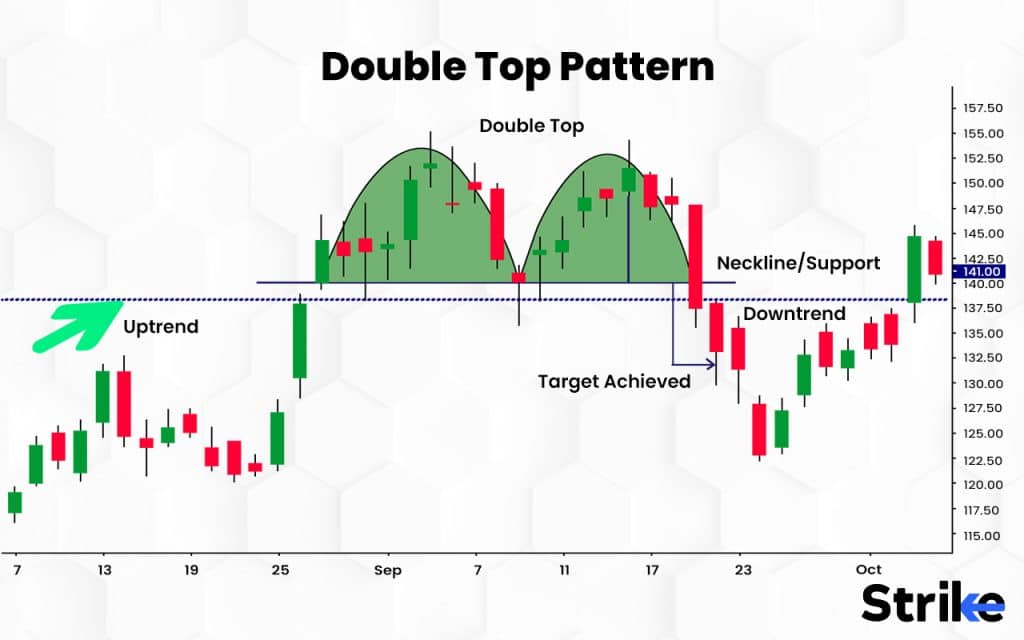
- Firstly, the trader should see the market phase, whether it is up or down. The Double Top Pattern is formed at the end of an uptrend as the prior trend should be an uptrend.
- Traders should spot if two Rounding Tops are forming and also note the size of the Tops.
- Traders should only enter the short position when the price breaks out from the support level or the neckline.
- The stop loss should be placed at the second top of the Pattern in the Double Top chart pattern.
- The price target should be equal to the Distance between the neckline and the Tops of the Double Top Pattern chart.
- Below is an example of the double top Pattern (Tata Motors Ltd).
Trading with Double Bottom:
- The trader should see the market phase, whether it is up or down. The Double Bottom is formed at the end of the downtrend, as the prior trend should be the downtrend.
- Traders should spot if two Rounding Bottoms are forming and also note the size of the bottoms.
- Traders should only enter the long position when the price breaks out from the resistance level or the neckline.
- The stop loss should be placed at the second bottom of the Double Bottom Pattern in the Double Bottom chart Pattern.
- The price target should be equal to the Distance between the neckline and the bottoms.
- Given below is an example of the Double Bottom Pattern (Tata Motors Ltd.)









 Previous Article
Previous Article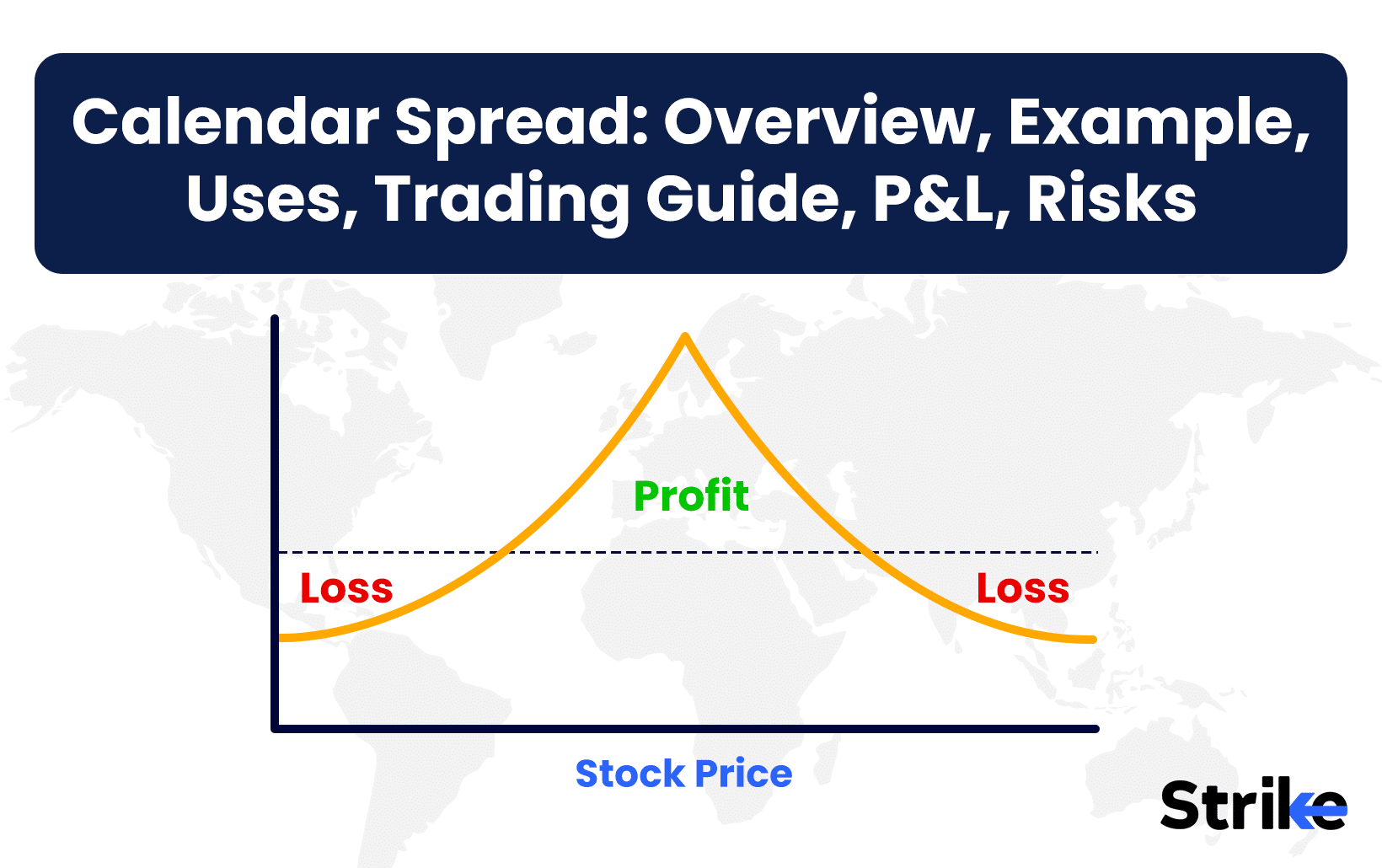
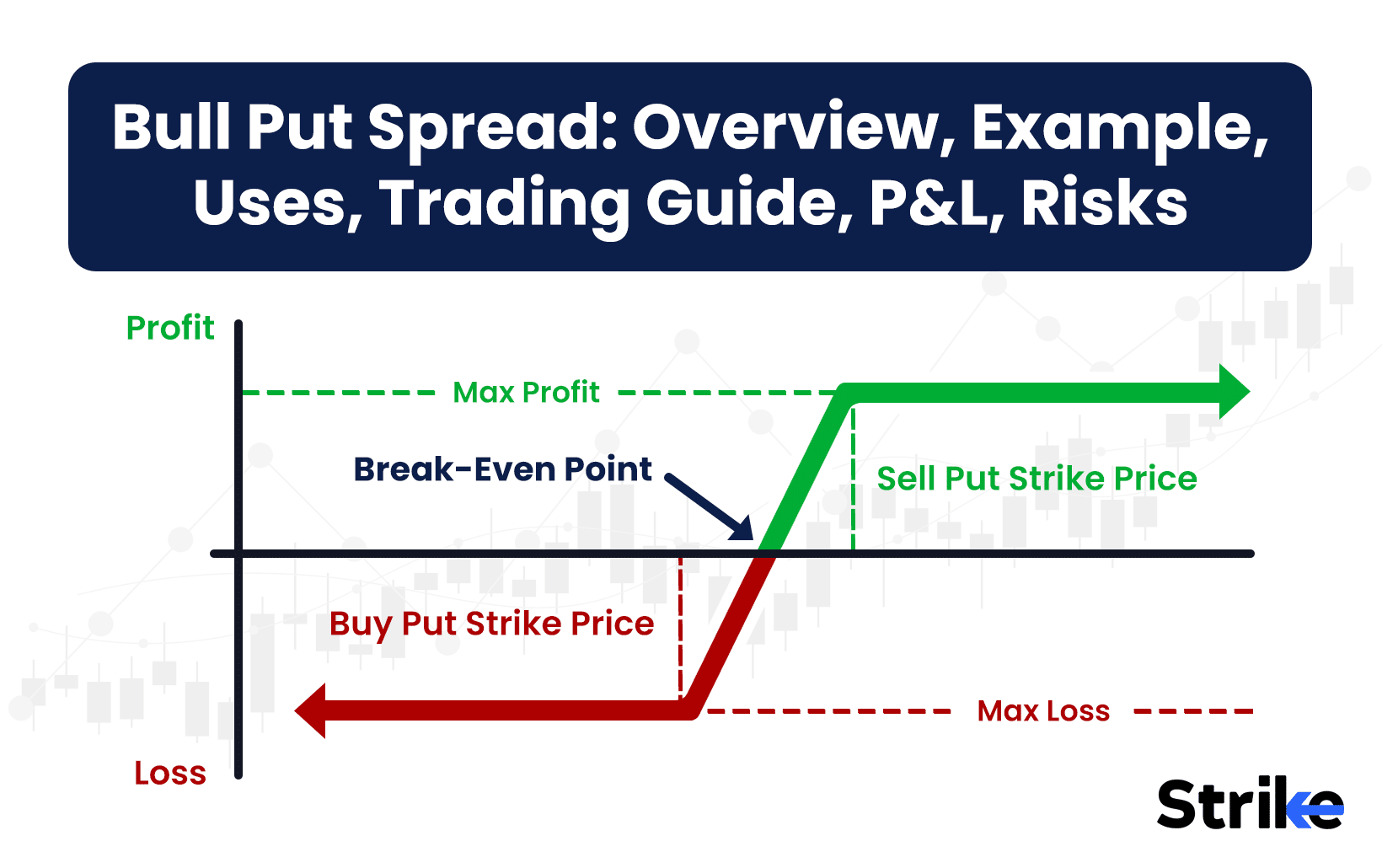





No Comments Yet